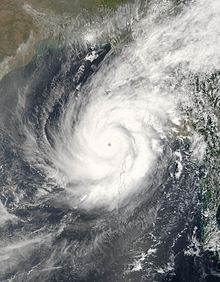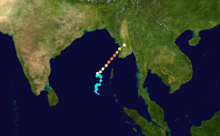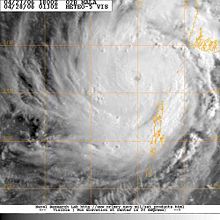- Cyclone Mala
-
Very Severe Cyclonic Storm Mala Very severe cyclonic storm (IMD) Category 4 cyclone (SSHS) 
Cyclone Mala on April 28 near peak intensity Formed April 25, 2006 Dissipated April 29, 2006 Highest winds 3-minute sustained:
185 km/h (115 mph)
1-minute sustained:
220 km/h (140 mph)Lowest pressure 954 mbar (hPa; 28.17 inHg) Fatalities 22 direct Damage $6.7 million (2006 USD) Areas affected Myanmar, northern Thailand Part of the 2006 North Indian Ocean cyclone season Cyclone Mala, also known as Very Severe Cyclonic Storm Mala, was the strongest tropical cyclone of the 2006 North Indian Ocean cyclone season. The equivalent of a Category 4 hurricane on the Saffir-Simpson Hurricane Scale, the storm was the strongest named cyclone in the Bay of Bengal at the time, as Cyclone Sidr was stronger in the 2007 season (though several stronger unnamed storms have existed.) Mala struck the coast of Burma with winds of 115 mph (185 km/h), causing $6.7 million (2006 USD) in damages and at least 22 deaths. Its minimum central pressure was 954 hPa (mbar). The next cyclone to hit Burma was Nargis in 2008, which was slightly weaker, but had a significantly greater impact.[1] The name Mala is Sinhalese as well as Hindi for a garland of flowers.[2]
Contents
Meteorological history
An area of convection persisted over the southern Bay of Bengal in mid- to late-April, and organized around a low level circulation on April 23.[3] Under light low-level shear, convection built around the system, and consolidated around the center.[4] The area continued to organize, and was upgraded by RSMC New Delhi to Deep Depression on the 25th. The deep depression moved to the northwest, and intensified into a Cyclonic Storm Mala later that day.
Steering currents were initially weak, and due to moderate southeasterly shear Mala remained a Cyclonic Storm. After drifting to the north, a trough of low pressure caused the storm to accelerate to the northeast.[5] The shear diminished, and continued favorable conditions allowed Mala to intensify into a Severe Cyclonic Storm on April 27.[6] Outflow became better defined as the eyewall contracted, and on the 28th Mala rapidly intensified to a 100-110kt (184–202 km/h) Very Severe Cyclonic Storm with an estimated central pressure of 954hPa according to the IMD; the JTWC estimated a peak of 140 mph, making it the first Category 4 cyclone recorded in this basin in the 21st century.[7] The cyclone weakened shortly after peaking in intensity,[8] and struck Gwa, a city 190 km (120 mi) to the northwest of Yangon in the Rakhine State with winds of 115 mph.[9] The storm rapidly weakened over land, and quickly dissipated after landfall.[8]
Preparations
In preparation for the storm, Burma officials evacuated 50,000 people from the coastline.[10] Storm warnings began on Burma's radio system three days prior to landfall.[11]
Bangladesh issued storm warnings for the southern portion of the country, though an actual landfall was never forecast.[9] 34,000 members of the Bangladesh Red Crescent Society were put on standby for the possible impact on the country. In addition, hundreds of fisherman returned to land after storm warnings were raised.[2]
Also, Thailand's Meteorological Department warned citizens for the threat of severe flooding in eight northwestern provinces.[12]
China Meteorological Agency warned that the outer rainbands of Mala might affect Yunnan province as early as April 27.[13] Two days later, forecasters expected rainy weather to spread across the whole province with rainstorm in southern part.[14]
Impact
Prior to making landfall, Mala sent powerful waves up the coastline of Burma.[15] Near the landfall area, 88 houses were completely destroyed, while 1,246 were damaged to some degree. 75% of all of the structures in Gwa Township were damaged. Temporary shelters following the storm included a monastery, two schools, and a meditation center.[16] Throughout the Burma coastline, four people were killed.[17] In addition, the offshore island of Haingyi experienced damage.[9]
Heavy rainfall in the northern Ayeyarwady Division killed eighteen people, with fourteen missing.[16] The area most affected by Mala was the city of Yangon. There, the strong winds tore the roofs of several buildings, with over 150 buildings being damaged. The industrial area faced severe damage as well. There, two factories were destroyed, while the powerful winds shattered windows on numerous buildings. The winds also downed numerous power lines, leaving many without electricity.[15] Heavy rainfall in the city clogged storm drains, leaving some downtown areas in 1 metre (3 feet) of water.[18] Throughout Burma, the cyclone killed 22 people and caused damage to over 6,000 houses, of which 351 were completely destroyed.[16]
See also
External links
References
- ^ Minimum Pressure Reading
- ^ a b Bangladesh coast under cyclone warning
- ^ April 23 Tropical Cyclone Warnings
- ^ April 24 Tropical Cyclone Warnings
- ^ April 26 Tropical Cyclone Warnings
- ^ April 27 Tropical Cyclone Warnings
- ^ April 28 Tropical Cyclone Warnings
- ^ a b April 29 Tropical Cyclone Warnings
- ^ a b c Cyclone Mala batters Burma's west coast
- ^ Cyclone Mala threatens to lash TN, AP coast
- ^ Cyclone Mala brings heavy rain
- ^ Cyclone Mala hits Burma, north and west Thailand
- ^ http://www.nmc.gov.cn/news/viewArticle.do?method=viewArticle&id=ff8080810abc41b5010ad92f193c0018
- ^ http://www.nmc.gov.cn/news/viewArticle.do?method=viewArticle&id=ff8080810abc41b5010ae3d9f00d0024
- ^ a b Cyclone Mala Batters Burma
- ^ a b c Burma: Cyclone Mala Information Bulletin No. 1
- ^ Cyclone death toll reaches 22
- ^ Cyclone abates in Burma, brings rain to capital
Categories:- Tropical cyclones in Burma
- 2006 North Indian Ocean cyclone season
- 2006 in Burma
- Very severe cyclonic storms
Wikimedia Foundation. 2010.


